The Reversal of Parity Law in Nuclear Physics
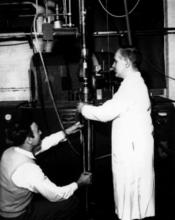
In late 1956, experiments at the National Bureau of Standards (NBS, now NIST) demonstrated that the quantum mechanical law of conservation of parity does not hold in the beta decay of cobalt-60 nuclei.1 This result, together with experiments on parity conservation in µ-meson decay at Columbia University, shattered a fundamental concept of nuclear physics that had been universally accepted for the previous 30 years. It thus cleared the way for a reconsideration of physical theories and led to new, far-reaching discoveries regarding the nature of matter and the universe.
In particular, removal of the restrictions imposed by parity conservation brought order to the theoretical chaos that existed with regard to subatomic particles. The "elementary" particles seen in cosmic rays and particle accelerator experiments were understood to be manifestations of the strong and weak nuclear interactions. The better understanding of their characteristics has led to a more unified theory of the fundamental forces.
The beta-decay experiments were carried out by C. S. Wu of Columbia University and NBS staff members Ernest Ambler, Raymond W. Hayward, Dale D. Hoppes, and Ralph P. Hudson. The Bureau's low temperature laboratory was chosen for the experiments because of its previous experience in low-temperature alignment of atomic nuclei,2 an essential feature of the beta-decay study.
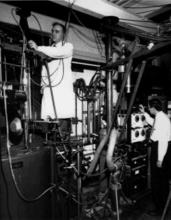
Basically, parity conservation in quantum mechanics means that two physical systems, one of which is a mirror image of the other, must behave in identical fashion. In other words, parity conservation implies that Nature is symmetrical and makes no distinction between right- and left-handed rotations or between opposite sides of a subatomic particle. Thus, for example, two similar radioactive particles spinning in opposite directions about a vertical axis should emit their decay products with the same intensity upwards and downwards.
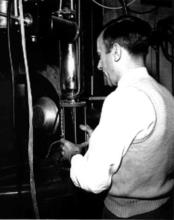
Since 1925, physicists had accepted the principle that the parity is conserved in all types of interactions. During the 1950's, however, phenomena were found in high-energy physics that could not be explained by existing theories. The available accelerators produced a variety of subatomic particles. One such particle is the short-lived K meson emitted in the collision of a high-energy proton with an atomic nucleus. The K meson seemed to arise in two distinct versions, one decaying into two, the other decaying into three π mesons, the two versions being identical in all other characteristics. A mathematical analysis showed that the two-pion and the three-pion systems have opposite parity; hence, according to the prevalent theory, these two versions of the K meson had to be different particles.
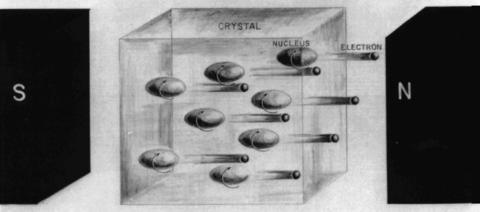
In the summer of 1956, T. D. Lee of Columbia University and C. N. Yang of the Institute for Advanced Study made a survey3 of experimental information on the question of parity. They concluded that the evidence then existing neither supported nor refuted parity conservation in the "weak interactions" responsible for the emission of beta particles, K-meson decay and such. They thus proposed that the K-meson itself may have definite parity, and the observed opposite parity of the two systems of decay products may be the manifestation of parity non-conservation in its decay. They also proposed a number of experiments on beta decays and hyperon and meson decays that would provide the necessary evidence for or against parity conservation in weak interactions. One of the proposed experiments involved measuring the directional intensity of beta radiation from oriented cobalt-60 nuclei. At the suggestion of Professor Wu of Columbia, arrangements were made to carry out this experiment in the Bureau's low temperature laboratory.
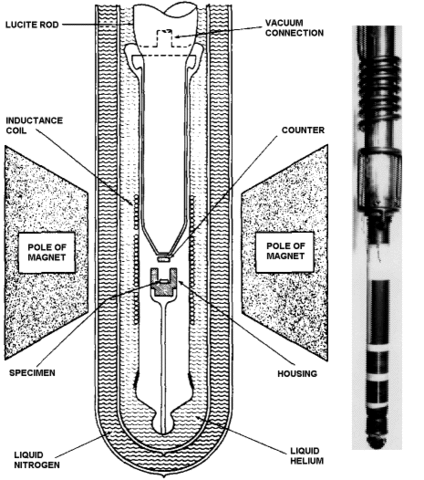
Polarization of the nuclei was achieved by cooling a paramagnetic crystal containing cobalt-60 to within 0.003 degrees of absolute zero (0.003 K), and subjecting it to a magnetic field. At this temperature the effects of thermal agitation are so small that atomic nuclei can line up in a given direction within the crystal lattice when a magnetic field is applied.
The magnetic polarity of the nucleus is determined by its direction of spin, and, under the influence of a magnetic field, most of the cobalt-60 nuclei align themselves so that their spin axes are parallel to the field.
As cobalt-60 is radioactive, its nuclei continuously emit beta and gamma rays. If parity is conserved in such interactions, then the intensity of the beta emission should be the same in either direction along the axis of spin. This, of course, was the critical question in the cobalt-60 experiments. It was resolved by measuring the intensity of beta emission in both these directions, i.e., along and against the field direction.
The cobalt-60 was located in a thin (50 µm) surface layer of a single crystal of cerium magnesium nitrate. The crystal was placed in an evacuated flask which in turn was immersed in liquid helium within a Dewar flask surrounded by liquid nitrogen. An inductance coil on the surface of the inner flask was used to measure the temperature of the crystal in terms of its magnetic susceptibility.
A major experimental problem was the location of a radiation counter within the evacuated flask for detection of beta particles. This problem was solved by placing a thin anthracene crystal inside the chamber to serve as a scintillation counter. The anthracene crystal was located about 2 cm above the cobalt-60 source. Scintillations caused by beta particles striking the crystal were transmitted through a glass window and a 120 cm lucite tube acting as a light pipe to a photomultiplier at the top of the flask. The resulting pulses were counted on a 10-channel pulse-height analyzer.
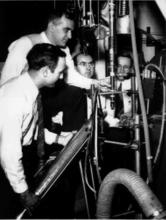
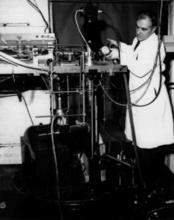
In addition to the beta counter within the vacuum chamber, two sodium iodide gamma scintillation counters were used externally to measure the directional intensity of the more penetrating gamma radiation. In this way the investigators were able to determine the degree of polarization of the cobalt-60 nuclei. The two gamma counters were biased to accept only the pulses from the photopeaks in order to discriminate against pulses from Compton scattering.
Cooling to the low temperature necessary for nuclear alignment was accomplished by the process of adiabatic demagnetization using a magnetic field of about 2.3 tesla (23,000 gauss). This process involved successive magnetization and demagnetization of the paramagnetic salt, cerium magnesium nitrate, which supported the cobalt-60 specimen. The heat produced by magnetization was removed by the boiling off of liquid helium in the surrounding Dewar. The specimen was then thermally isolated and upon demagnetization the temperature fell to about 0.003 K.
A vertical solenoid was then raised around the lower end of the outer Dewar to provide a magnetic field for polarization of the cobalt-60 nuclei. After the beta emission had been measured for this condition, the direction of the magnetic field was reversed, and the beta emission again measured for the nuclei now polarized in the opposite direction. It was found that the emission of beta particles is greater in the direction opposite to that of the nuclear spin. Thus, a spinning cobalt-60 nucleus has a beta emission distribution that is not the same as that of its mirror image. This result unequivocally demonstrated that parity is not conserved in the emission of beta particles by cobalt-60.
Page 90 of Ernest Ambler's Notebook for the Experiment on December 27, 1956.
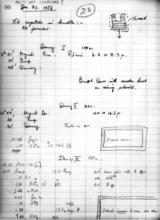
The first entries below the date were made by Ambler. The first of two successful runs began at 12:04 (middle of page). Hudson's notation "Field on" (directly under "Demag II") refers to the magnetic field produced by the solenoid. An initially high counting rate of β particles (emitted by the cobalt-60 nuclei as polarized by this field) was observed to decrease to the value for randomly oriented nuclei as the polarization decreased because of the gradual warming of the cobalt-60 nuclei ("β counts decrease," boxed for emphasis).
After again cooling the crystal and then polarizing the cobalt-60 nuclei in the opposite direction (by reversing the direction of the solenoid current and thus the magnetic-field direction), the NBS physicists observed the opposite behavior of the β-particle counts with time -- the counts gradually increased from an initially low value to the value for randomly oriented nuclei. These two results were what they had been looking for. Hudson later added "PARITY NOT CONSERVED!" at the top of the page.
A second experiment was then performed using cobalt-58, which is a positron emitter. In this case the opposite effect was observed, namely that β+ particles are preferentially emitted along the direction of the nuclear spins. This provided additional confirmation of the theory and constituted a convincing demonstration of the basic validity of the experiments.
The further developments of the theory, together with a large number of follow-up experiments, has led to the unification of the weak and electromagnetic interactions. A description of both the history and the physics is available in the Nobel lectures by Weinberg, Salam, and Glashow.4
- An experimental test of parity conservation in beta decay, by C. S. Wu, E. Ambler, R. W. Hayward, D. D. Hoppes, and R. P. Hudson, Phys. Rev. 105, 1413 (1957).
- Low-temperature alignment of radioactive nuclei, NBS Tech. News Bul. 40, 49 (April 1956); see also E. Ambler, R. P. Hudson, and G. M. Temmer, Phys. Rev. 97, 1212 (1955) and 101, 1096 (1956).
- Question of parity conservation in weak interactions, by T. D. Lee and C. N. Yang, Phys. Rev. 104, 254 (1956).
- S. Weinberg, Rev. Mod. Phys. 52, 515 (1980); A. Salam, p. 525; and S. L. Glashow, p. 539.

